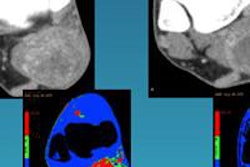
SAN FRANCISCO - A new analysis of radiation therapy costs presented at this week's American Society for Radiation Oncology (ASTRO) meeting has found wide variations that aren't related to patient or disease factors. Costs varied between standalone centers and hospital departments -- a variance that has since been flattened by changes in Medicare reimbursement.
Researchers from the University of California, San Diego (UCSD) found that radiation therapy costs varied more based on factors such as the geographic location where treatment was provided and whether the provider was a hospital or a standalone center, as opposed to the type of patient or the disease, according to study presenter Dr. Anthony Paravati.
The findings hint at the rationale behind the dramatic double-digit reimbursement cuts implemented in 2012 by the U.S. Centers for Medicare and Medicaid Services (CMS) for radiation oncology services delivered at community radiation oncology centers -- cuts that were strenuously opposed by the radiation oncology community at the time.
SEER data
Paravati and colleagues wanted to get a better handle on what was contributing to radiation therapy costs for three of the most common diseases.
"Our goal was to identify and quantify sources of variation in the cost to society of a course of radiation therapy for the highest-volume indications," he said. "We found that factors unrelated to the individual patient or disease account for a large portion of the variation in cost of radiation therapy for breast, lung, and prostate cancer."
They used data from the Surveillance, Epidemiology, and End Results (SEER) Medicare database, a collection of individual cancer registries across the U.S. that is overseen by the U.S. National Cancer Institute. The database included approximately 100,000 patients diagnosed between 2004 and 2009 with nonmetastatic breast, lung, or prostate cancer who had been treated with radiation.
Once Paravati's group excluded patients for various reasons (i.e., those who had breast or lung cancer and had undergone intensity-modulated radiation therapy [IMRT], and those with prostate cancer who had not received IMRT, among other factors), the cohort consisted of 33,084 patients.
The group determined the cost of a course of radiation for each patient by adding reimbursement amounts from Medicare billing claims for radiation treatment, weekly management, and treatment planning. The cost included amounts paid by Medicare and those owed by the beneficiary, Paravati told ASTRO session attendees.
They then divided costs into two general categories of factors that influence variation in radiotherapy expenses, he said: Patient and disease factors and provider-associated factors.
Patient- and disease-related factors include disease stage; age, gender, and race; socioeconomic status; complexity of disease; type of surgery; and underlying health status. Provider-associated costs include the U.S. state in which the patient receives treatment, population density, the individual radiation provider, and the clinic type (freestanding, hospital, or academic centers).
Total cost for the entire cohort of 33,084 patients across the study timeline was about $500 million. Median cost for radiation treatment for breast and lung cancer patients was similar, at $8,300 and $8,600, respectively. But for prostate cancer, the cost was quite a bit higher, at $20,200, because the standard treatment is IMRT, Paravati said.
Patient vs. provider
When it came to determining which factor had a bigger effect on costs, Paravati and colleagues found that patient-based factors only accounted for 1% to 3% of cost variation. Meanwhile, provider-based factors accounted for variations ranging from 50% to 77%, after controlling for patient and tumor characteristics.
For example, if patients were treated at a freestanding radiation oncology center, costs were 54% higher for breast cancer, 63% higher for lung cancer, and 69% higher for prostate cancer.
Much of that difference can be attributed to different Medicare payment rates, Paravati said. He noted that during the study period, Medicare was reimbursing freestanding centers at a rate 77% higher than hospital-based centers for the same IMRT prostate treatments.
"Prostate cancer has a bimodal cost distribution, reflecting different reimbursement at hospital versus freestanding clinics," he said. "In 2009, the mean cost of prostate IMRT was $17,700 for hospital facilities and $31,300 for freestanding facilities. As we know, since this time period, steps have been taken to address this difference."
Those steps include the sharp cut in payments to radiation therapy centers that was implemented by Medicare in 2013.
Geographic location also had an effect on cost variation, with some geographic locations turning in costs that were 50% higher than others for treating the same types of cancer.
"The cost of radiation therapy for all disease sites was lowest in Hawaii," Paravati said. "Louisiana was highest for prostate, while Washington state was highest for lung and breast."
Do these variations translate into better results for patients? It's unclear, Paravati concluded.
"Future research should focus on determining whether these cost differences translate into improved outcomes -- though our findings suggest inefficiencies in radiation therapy costs," he said.




















